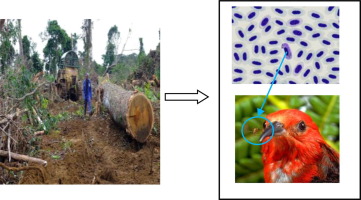当前位置:
X-MOL 学术
›
Int. J. Parasitol.
›
论文详情
Our official English website, www.x-mol.net, welcomes your feedback! (Note: you will need to create a separate account there.)
Effect of deforestation on prevalence of avian haemosporidian parasites and mosquito abundance in a tropical rainforest of Cameroon.
International Journal for Parasitology ( IF 4 ) Pub Date : 2019-12-19 , DOI: 10.1016/j.ijpara.2019.10.006 Mélanie Adèle Tchoumbou 1 , Marie Paul Audrey Mayi 1 , Elikwo N F Malange 2 , Forfuet David Foncha 2 , Cyril Kowo 2 , Jerome Fru-Cho 2 , Timoléon Tchuinkam 1 , Julius Awah-Ndukum 3 , Robert Dorazio 4 , Damian Nota Anong 2 , Anthony John Cornel 5 , Ravinder N M Sehgal 4
International Journal for Parasitology ( IF 4 ) Pub Date : 2019-12-19 , DOI: 10.1016/j.ijpara.2019.10.006 Mélanie Adèle Tchoumbou 1 , Marie Paul Audrey Mayi 1 , Elikwo N F Malange 2 , Forfuet David Foncha 2 , Cyril Kowo 2 , Jerome Fru-Cho 2 , Timoléon Tchuinkam 1 , Julius Awah-Ndukum 3 , Robert Dorazio 4 , Damian Nota Anong 2 , Anthony John Cornel 5 , Ravinder N M Sehgal 4
Affiliation

|
Habitat change caused by deforestation can modify the interactions of many biotic and abiotic factors, and in turn influence patterns of diseases in wild birds. Whether deforestation directly or indirectly affects the prevalence of avian haemosporidian parasites through their hosts and/or vectors is still not well understood. We sampled understory bird communities (insectivorous, frugivorous, granivorous and nectarivorous birds) and mosquitoes in three habitats showing a gradient of deforestation (pristine forest, fragmented forest, and young palm oil plantation), to assess the effects of habitat changes on avian haemosporidian (Plasmodium and Haemoproteus) prevalence and its relationship to bird feeding guilds and mosquito abundance. Blood samples of 845 individual birds belonging to 85 species and 27 families were collected in the three habitat types and screened using microscopy and PCR. Plasmodium infections were detected in 136 individuals (16.09%) and varied significantly among habitat types while Haemoproteus infections were detected in 98 individuals (11.60%) and did not vary significantly among habitat types. However, the prevalence of Plasmodium and Haemoproteus in bird feeding groups varied significantly among habitats. Nectarivorous and granivorous birds had the highest Plasmodium and Haemoproteus prevalence, respectively. The abundance of mosquitoes varied significantly among habitat types and the prevalence of Plasmodium significantly and positively correlated with mosquito abundance in fragmented forest. This study highlights the importance of host and mosquito determinants in the transmission dynamics of avian Plasmodium and Haemoproteus infections following habitat changes. Selective logging favored an increase in the prevalence of Plasmodium in insectivores, the prevalence of Haemoproteus in nectarivores and the abundance of female mosquitoes while, the establishment of the palm oil plantation favored an increase in the prevalence of Plasmodium in granivores and Haemoproteus in nectarivores. Species feeding behavior is also an important determinant to consider for a better understanding of patterns of parasite infections in a changing environment.
中文翻译:

喀麦隆热带雨林中森林砍伐对鸟类血友病寄生虫流行和蚊子丰富的影响。
森林砍伐引起的生境变化可以改变许多生物和非生物因素的相互作用,进而影响野生鸟类的疾病模式。砍伐森林是通过其宿主和/或媒介直接或间接影响禽血吸虫病寄生虫的流行仍未得到很好的了解。我们在三个森林砍伐呈梯度变化的栖息地(原始森林,零散森林和年轻的棕榈油种植园)中采样了地下鸟类群落(食虫,食肉,食肉和肉食性鸟类)和蚊子,以评估栖息地变化对禽血孢子虫的影响(疟原虫和嗜血杆菌的患病率及其与鸟类喂食行会和蚊子丰度的关系。在这三种栖息地类型中收集了来自85个物种和27个科的845只鸟类的血样,并使用显微镜和PCR进行了筛选。在136个个体中检出了疟原虫感染(16.09%),并且在生境类型之间存在显着差异,而在98个个体中检出的血型变形杆菌感染(11.60%)在生境类型之间没有显着差异。但是,鸟类饲喂组中的疟原虫和变形血红蛋白的患病率在栖息地之间存在显着差异。肉食性和肉食性鸟类的疟原虫和血生变形杆菌患病率最高。在不同的生境类型中,蚊子的丰度差异很大,而疟原虫的患病率与零散森林中的蚊虫的丰度显着正相关。这项研究强调了宿主和蚊子决定因素在栖息地变化后禽疟原虫和血红蛋白感染的传播动力学中的重要性。选择性伐木有利于食虫中疟原虫的流行,油桃中嗜血杆菌的流行和雌性蚊子的丰富,而棕榈油种植园的建立则有利于食肉动物中疟原虫的流行和油桃中嗜血菌的流行。物种的进食行为也是要考虑的一个重要决定因素,以便更好地了解不断变化的环境中的寄生虫感染方式。选择性伐木有利于食虫中疟原虫的流行,油桃中嗜血杆菌的流行和雌性蚊子的丰富,而棕榈油种植园的建立则有利于食肉动物中疟原虫的流行和油桃中嗜血菌的流行。物种的进食行为也是要考虑的一个重要决定因素,以便更好地了解不断变化的环境中的寄生虫感染模式。选择性伐木有利于食虫中疟原虫的流行,油桃中嗜血杆菌的流行和雌性蚊子的丰富,而棕榈油种植园的建立则有利于食肉动物中疟原虫的流行和油桃中嗜血菌的流行。物种的进食行为也是要考虑的一个重要决定因素,以便更好地了解不断变化的环境中的寄生虫感染方式。
更新日期:2019-12-19
中文翻译:

喀麦隆热带雨林中森林砍伐对鸟类血友病寄生虫流行和蚊子丰富的影响。
森林砍伐引起的生境变化可以改变许多生物和非生物因素的相互作用,进而影响野生鸟类的疾病模式。砍伐森林是通过其宿主和/或媒介直接或间接影响禽血吸虫病寄生虫的流行仍未得到很好的了解。我们在三个森林砍伐呈梯度变化的栖息地(原始森林,零散森林和年轻的棕榈油种植园)中采样了地下鸟类群落(食虫,食肉,食肉和肉食性鸟类)和蚊子,以评估栖息地变化对禽血孢子虫的影响(疟原虫和嗜血杆菌的患病率及其与鸟类喂食行会和蚊子丰度的关系。在这三种栖息地类型中收集了来自85个物种和27个科的845只鸟类的血样,并使用显微镜和PCR进行了筛选。在136个个体中检出了疟原虫感染(16.09%),并且在生境类型之间存在显着差异,而在98个个体中检出的血型变形杆菌感染(11.60%)在生境类型之间没有显着差异。但是,鸟类饲喂组中的疟原虫和变形血红蛋白的患病率在栖息地之间存在显着差异。肉食性和肉食性鸟类的疟原虫和血生变形杆菌患病率最高。在不同的生境类型中,蚊子的丰度差异很大,而疟原虫的患病率与零散森林中的蚊虫的丰度显着正相关。这项研究强调了宿主和蚊子决定因素在栖息地变化后禽疟原虫和血红蛋白感染的传播动力学中的重要性。选择性伐木有利于食虫中疟原虫的流行,油桃中嗜血杆菌的流行和雌性蚊子的丰富,而棕榈油种植园的建立则有利于食肉动物中疟原虫的流行和油桃中嗜血菌的流行。物种的进食行为也是要考虑的一个重要决定因素,以便更好地了解不断变化的环境中的寄生虫感染方式。选择性伐木有利于食虫中疟原虫的流行,油桃中嗜血杆菌的流行和雌性蚊子的丰富,而棕榈油种植园的建立则有利于食肉动物中疟原虫的流行和油桃中嗜血菌的流行。物种的进食行为也是要考虑的一个重要决定因素,以便更好地了解不断变化的环境中的寄生虫感染模式。选择性伐木有利于食虫中疟原虫的流行,油桃中嗜血杆菌的流行和雌性蚊子的丰富,而棕榈油种植园的建立则有利于食肉动物中疟原虫的流行和油桃中嗜血菌的流行。物种的进食行为也是要考虑的一个重要决定因素,以便更好地了解不断变化的环境中的寄生虫感染方式。


























 京公网安备 11010802027423号
京公网安备 11010802027423号